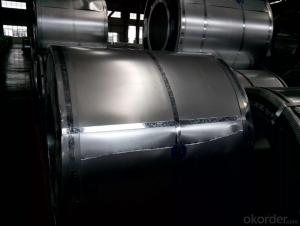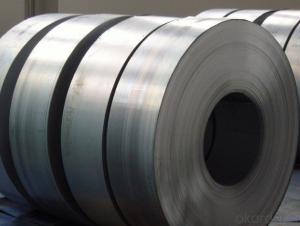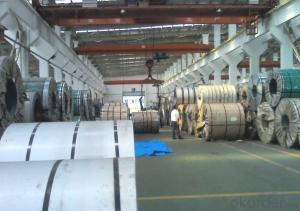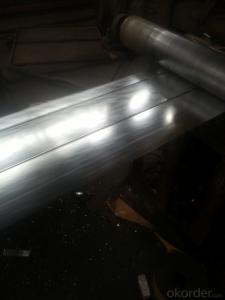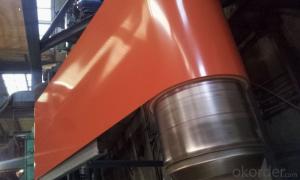Hot Dipped Galvanized Steel Strip Coil
- Loading Port:
- China Main Port
- Payment Terms:
- TT OR LC
- Min Order Qty:
- -
- Supply Capability:
- -
OKorder Service Pledge
Quality Product, Order Online Tracking, Timely Delivery
OKorder Financial Service
Credit Rating, Credit Services, Credit Purchasing
You Might Also Like
Hot Dip Galvanized Steel Strip Coil
Steel Grade & Standard:JIS G3302 SGHC
Zinc Coating Mass:Z14
Spangle:Regular Spangle
Surface Treatment:CHROMATED & UNOILED
Thickness:3.7mm
Width:620mm
Coil ID:610mm
Coil Weight:4MTS MIN
- Q:What are the common width variations in steel strips?
- The specific application and industry requirements determine the common width variations in steel strips. However, the steel industry typically includes several standard width variations. 1. Narrow Width Strips: These strips are less than 600mm in width and are commonly utilized in specialized applications such as automotive components, electrical appliances, and precision engineering. 2. Medium Width Strips: Ranging from 600mm to 1,000mm in width, these steel strips are commonly employed in industries like construction, manufacturing, and general engineering. 3. Wide Width Strips: With a width exceeding 1,000mm, these steel strips find their use in heavy-duty applications such as shipbuilding, construction of large structures, and manufacturing of industrial machinery. It is important to consider that these width variations are not fixed and can be tailored according to specific project requirements. Steel mills and manufacturers often offer a wide range of width options to accommodate different needs. Moreover, the tolerances and precision of the width measurements may vary based on industry standards and customer specifications.
- Q:Can steel strips be used for making stamping dies or molds?
- Yes, steel strips can be used for making stamping dies or molds. Steel strips are commonly used in the manufacturing industry for their high strength, durability, and ability to withstand high levels of pressure and wear. They can be shaped, cut, and formed into various shapes and sizes to create stamping dies or molds, which are essential tools for shaping and forming materials in industrial processes such as metal stamping or plastic injection molding.
- Q:How are steel strips coated with zinc?
- Galvanization is the process by which steel strips are coated with zinc. There are two primary methods utilized for this purpose: hot-dip galvanization and electro-galvanization. In hot-dip galvanization, the steel strips are submerged in a bath of molten zinc at a temperature of approximately 450 degrees Celsius (842 degrees Fahrenheit). The strips are carefully cleaned to eliminate impurities and undergo several pre-treatment stages, including acid pickling and fluxing, to improve the adhesion of the zinc coating. Once adequately prepared, the strips are immersed in the molten zinc bath, where a reaction occurs between the zinc and the steel surface, resulting in the formation of a protective layer. This zinc coating adheres firmly to the steel and provides exceptional resistance against corrosion. On the other hand, electro-galvanization is a process that entails applying a thin layer of zinc onto the steel strips through electroplating. Initially, the strips are cleaned and then submerged in an electrolyte solution containing zinc ions. An electric current is passed through the solution, causing the zinc ions to be attracted to and deposited onto the steel surface. This method allows for a more precise and controlled coating thickness, making it suitable for applications that require a thinner coating. Both hot-dip galvanization and electro-galvanization are effective techniques for coating steel strips with zinc, resulting in a protective layer that significantly enhances their durability and corrosion resistance. The choice between the two methods depends on various factors, including the desired coating thickness, specific application requirements, and cost considerations.
- Q:What is the length range of steel strips?
- The length range of steel strips can vary depending on the specific application and manufacturing process, but typically they can range from a few inches to several hundred feet.
- Q:What is the purpose of steel strips?
- The purpose of steel strips is to provide strength, durability, and stability in various applications such as construction, manufacturing, automotive, and packaging industries. They are commonly used as reinforcement in concrete structures, as raw material for making various products, and in packaging to secure and protect goods during transportation.
- Q:What are the factors affecting the cost of steel strips?
- The cost of steel strips can be influenced by various factors. Firstly, the price of the raw materials used in their production is a significant determinant. If the cost of iron ore, coal, and other materials utilized in steelmaking rises, it will directly impact the cost of steel strips. Another crucial factor is the supply and demand dynamics within the steel industry. When there is high demand for steel strips but limited supply, the cost is likely to increase. Conversely, if the demand is low and there is an excess supply, prices may decrease. Energy price fluctuations can also impact the cost of steel strips. Since the steel manufacturing process requires a substantial amount of energy, any increase in energy costs will raise the overall production expenses, thereby affecting the price of steel strips. Transportation costs also play a role. If steel strips need to be transported over long distances, the expenses related to shipping and logistics can contribute to the overall cost. Moreover, the level of competition within the steel industry can influence the cost of steel strips. With intense competition among steel manufacturers vying for market share, they may lower their prices to attract customers. Conversely, if there are fewer competitors, they may have greater pricing power, resulting in higher costs. Finally, government policies and regulations can impact the cost of steel strips. Tariffs, taxes, and trade restrictions can increase the cost of imported steel strips, while subsidies or incentives can affect the cost of domestically produced steel. In conclusion, the cost of steel strips is influenced by factors such as raw material prices, supply and demand dynamics, energy costs, transportation expenses, competition, and government policies. These factors are subject to change over time, leading to fluctuations in the cost of steel strips.
- Q:How do steel strips perform under high temperatures?
- Steel strips generally perform well under high temperatures. Steel is known for its high melting point, which ranges from 1370°C to 1520°C (2500°F to 2750°F), depending on the specific type of steel. This means that steel strips can withstand extremely high temperatures without melting or losing their structural integrity. At elevated temperatures, steel strips also exhibit good thermal stability. They have a low thermal expansion coefficient, which means they expand and contract less compared to other materials. This property helps prevent warping or deformation of the strips when exposed to high temperatures. Steel strips also possess excellent strength and hardness even at elevated temperatures. While the strength of steel decreases slightly as temperatures rise, it still remains much stronger than many other materials. This makes steel strips suitable for applications where high temperature resistance and mechanical strength are essential, such as in furnaces, boilers, and heat exchangers. However, it is important to note that prolonged exposure to extremely high temperatures can lead to some changes in the properties of steel strips. At very high temperatures, steel can undergo oxidation or scaling, which may result in a loss of surface quality or corrosion resistance. Additionally, repeated heating and cooling cycles can lead to thermal fatigue, causing the steel to become more brittle over time. Therefore, it is necessary to consider these factors and choose the appropriate steel grade and surface treatment to ensure optimal performance under high temperature conditions.
- Q:Can steel strips be used for making surgical instruments?
- Yes, steel strips can be used for making surgical instruments. Steel strips are commonly used in the manufacturing of various surgical instruments due to their strength, durability, and resistance to corrosion. Their versatility allows for precise shaping and forming of surgical tools, ensuring high-quality and reliable instruments for medical procedures.
- Q:How are steel strips used in the manufacturing of kitchenware?
- Steel strips are commonly used in the manufacturing of kitchenware as they provide a strong and durable material for creating various utensils, cookware, and appliances. These strips are often cut and shaped into different forms, such as pots, pans, knives, or cutlery, and then undergo processes like stamping, bending, and welding to achieve the desired shape and function. Steel strips are favored due to their resistance to heat, corrosion, and wear, making them ideal for withstanding the demanding conditions of a kitchen environment.
- Q:How are steel strips tested for oil or grease residues?
- To guarantee the cleanliness and appropriateness of steel strips for further processing, various methods are employed to detect oil or grease residues. The solvent extraction method is a frequently utilized technique, involving the utilization of a nonpolar organic solvent like hexane or acetone to dissolve any oil or grease present on the steel strip's surface. The steel strip is submerged in the solvent and agitated to aid in the dissolution of the residues. Subsequently, the solvent is separated from the strip, and the extracted oil or grease is measured either gravimetrically or through analytical techniques such as gas chromatography. Another commonly employed method is the water break test. This test involves applying a thin film of water onto the steel strip's surface. If any oil or grease residues exist, they hinder the formation of a uniform film, leading to the water breaking into droplets or forming irregular patterns. The presence of these droplets or patterns signifies the existence of oil or grease residues. Furthermore, visual inspection and touch tests can be conducted to identify any visible or tactile indications of oil or grease on the steel strip. Trained inspectors thoroughly examine the strip's surface under appropriate lighting conditions and employ their sense of touch to detect any oily or greasy residues. Overall, a combination of solvent extraction, water break test, visual inspection, and touch tests are frequently employed to ensure that steel strips are devoid of oil or grease residues. These tests play a pivotal role in maintaining the quality and cleanliness of the steel strips, thereby ensuring their suitability for subsequent processing and applications.
1. Manufacturer Overview |
|
|---|---|
| Location | |
| Year Established | |
| Annual Output Value | |
| Main Markets | |
| Company Certifications | |
2. Manufacturer Certificates |
|
|---|---|
| a) Certification Name | |
| Range | |
| Reference | |
| Validity Period | |
3. Manufacturer Capability |
|
|---|---|
| a)Trade Capacity | |
| Nearest Port | |
| Export Percentage | |
| No.of Employees in Trade Department | |
| Language Spoken: | |
| b)Factory Information | |
| Factory Size: | |
| No. of Production Lines | |
| Contract Manufacturing | |
| Product Price Range | |
Send your message to us
Hot Dipped Galvanized Steel Strip Coil
- Loading Port:
- China Main Port
- Payment Terms:
- TT OR LC
- Min Order Qty:
- -
- Supply Capability:
- -
OKorder Service Pledge
Quality Product, Order Online Tracking, Timely Delivery
OKorder Financial Service
Credit Rating, Credit Services, Credit Purchasing
Similar products
New products
Hot products
Related keywords
